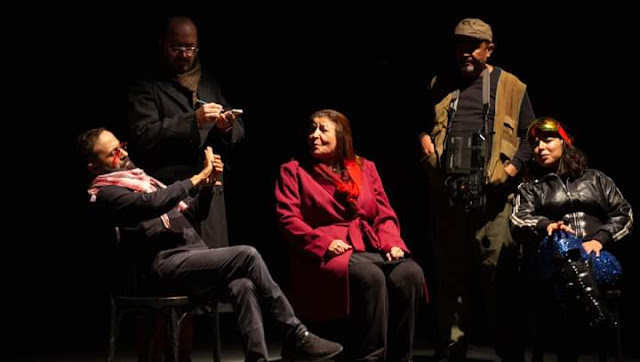A Cinematic Offering on the Theater Stage
Much like a Sufi soul shedding its physical constraints, the viewer’s mind in "Sky Dance" is freed from the fixed perspective of a theater seat. Directed by Taher Issa Ben Larbi, this work invites the audience to journey beyond the proscenium, flowing seamlessly from the stage to behind the camera, from the depths of the revolving screen to the depths of the characters’ lives. In each scene, "Sky Dance" dismantles boundaries between reality and imagination, creating an immersive experience that feels like a hybrid of theater and cinema.
Sky Dance intertwines two narratives: the story of Hala, the central figure of her family, who, at various times, is both mother and daughter, resentful wife, and lover of an author whose book transports her to the spiritual realms of Shams al-Din Tabrizi and Jalal al-Din Rumi. The frequent transitions between Hala’s modern-day reality and the 13th century are rendered through a rapid visual rhythm and an inventive scenography that serve as dramaturgical elements in themselves.
The scenography and imagery, guided by the inventive dramaturgy, create moments of visual allure and beauty. The cinematographic setup and onstage illusions allow the director to bring cinematic techniques to life on stage. Through the use of clapperboards, cameras, and booms, the play transitions from dramatic action to moments of filming, breaking down the boundaries between cinema and theater.
The play’s visual language captivates with its rich imagery and shifting perspectives, maintaining the viewer’s interest even throughout the two-hour runtime. This ambitious work introduces daring aesthetic techniques that challenge the prevailing “aesthetic orthodoxy” in contemporary theater, as described by artist Anouar Chaafi.
While the contrasting costumes and dialects of the two eras add depth, it is the pure love and desire for freedom that unites the characters. These are universal human experiences, depicted vividly and profoundly. This piece is an aesthetic adventure that invites the viewer to explore it from multiple angles, even through the lens of a camera held by actor Mounir Khazri on stage.
Each visual element resonates with the clarity and intrigue of an iconic artwork, like the eyes of the Mona Lisa or the mysterious painting in the opening scene of Naguib Mahfouz’s novel “The Beggar.” In this journey from a doctor’s clinic to a path of spiritual enlightenment, the scenes mirror the yearning for freedom and transcendence.
Cast and Crew:
- Written and Directed by: Taher Issa Ben Larbi
- Starring: Mona Nour El-Din, Hajar Hammouda, Khaled Al-Zeidi, Lazhar Farhani, Abdelkrim Benani, Shaima Al-Zazzou, Hamza Al-Warttani, Mounir Khazri, Iman Al-Manai, Amina Al-Mahboul
- Assistant Director: Hajar Hammouda
- Costume Execution: Marwa Mansouri
- Sound Engineers: Saber Al-Qasimi, Imad Hamdi
- Broadcast Technology: Mohamed Amin Bel Said, Fares Al-Nafzi
- Set Design: Mounir Ben Youssef
- Lighting Setup: Kamal Al-Sabbani
- Accessories Setup: Ihab Mandara
- Production Management: Imad Al-Midouni
- Produced by: Tunisian National Theater, in partnership with the Dramatic and Performing Arts Center in Kairouan and Zaghouan.
This unique work offers a layered, visually stunning experience that transcends theater’s traditional boundaries, crafting an intricate blend of mysticism, love, and cinematic expression on the theatrical stage.



0 Comments